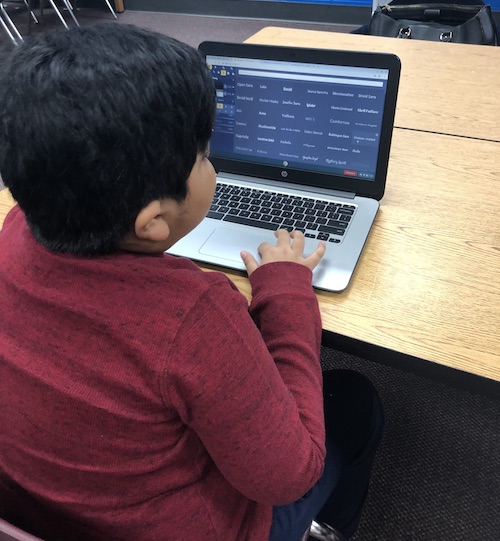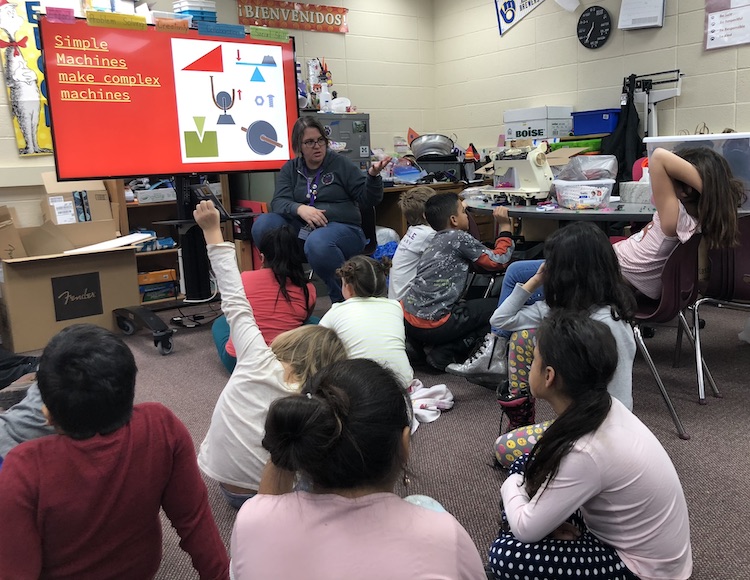Leo loves fonts and wants to design them someday. Zoey likes to explore careers and new materials in the Spotlight Station. Amy enjoys building small cardboard houses for her dolls. Jaycob likes to build and take apart technology.
These third-graders at Madison Metropolitan School District’s Glendale Elementary School spend one period each week in teacher Sara Milewski’s class, called the FAB (Fostering Active Brains) Lab. It’s a place where STEAM (science, technology, engineering, arts and math) skills develop through maker education.
Glendale is one of 15 MMSD schools currently offering maker education through a partnership with the Bubbler at Madison Public Library. The library’s role is to jump start and maintain maker education in Madison’s participating classrooms. A $200,000 grant from Schmidt Futures — obtained by Madison Public Library Foundation — provides training and support from Bubbler Youth Services Librarian Rebecca Millerjohn, instruction from various “Bubblearians,”and dollars to purchase furniture and other items for Milewski and teaching partner Nancy Engle’s classroom. The nonrestricted nature of the grant is important because it’s often hard to purchase consumable materials, furniture or professional development for teachers with other school district funds. And to measure Making Spaces’ effectiveness, the foundation awarded the Bubbler a $15,000 grant from the Program Venture Fund to develop an observational app prototype that assesses programming with evaluation criteria.
The Making Spaces program is a research practice partnership led by Maker Ed and the
Children’s Museum of Pittsburgh, with support from Google’s Making & Science initiative. The goal is to sustainably integrate making into learning environments throughout the country. The Bubbler serves as a Midwest hub for Making Spaces.

A Thriving Partnership
When the Bubbler started participating in Making Spaces in 2017, it was the only library in the program and the only site that worked with only one school district — which Millerjohn credits with its success. Madison started with seven participating schools, and today there are 15; the two newest are Black Hawk Middle School and Glenn Stephens Elementary School.
“This project has helped us form a really good relationship with the school district,” she said, which will allow the Bubbler to identify more ways to partner in the future.
At Glendale, Milewski and Engle work with kindergartners through fifth-graders throughout the day. Their class is part of MMSD’s REACH program, which stands for Reinforcing and Enriching Achievement for All Children.
“In a role like this, you have to be a jack of all trades,” Milweski explained.
Millerjohn leads personalized monthly professional development training for participating schools’ teachers and media specialists. The library connects teachers with artists-in-residence, library staff and other professionals who can help them expand their skills.
Student Skills Development
Students in the maker classes are exposed to a wide variety of activities, from sewing and tinkering with small machinery to coding and stop-motion animation on computers. Milewski presents a new focus each month — for instance, sound. In October, students learned how sound waves travel, and how to create and change sound through musical instruments. In November, the focus turned to simple machines, and December’s focus is coding.
Glendale’s maker classroom strives to build five Skills for Learning: Effort, Problem Solving, Creativity, Collaboration and Social Skills. Perhaps the best part of Making Spaces is how much the kids enjoy the activities. “Oh my gosh, they love it!” Milewski said. “They love, love, love it.” Her student surveys show that nearly all students look forward to Glendale’s maker programming and don’t want to miss their FAB Lab time.
Becoming a Classroom
To become a Making Spaces classroom, schools had to apply. Millerjohn said the selection panel considered the diversity of the school’s team, as well as equity and diversity of the student population. It also looked for visions and plans that aligned with the Bubbler’s.
“We really wanted schools who wanted to do this work not just in the library, but in classrooms,” Millerjohn said. “We wanted to get schools that were trying to use maker education as a way to help kids who were struggling.”
The Bubbler presents opportunities for Making Spaces teachers to gain opportunities to connect with local experts, and to attend and present at maker conferences and workshops like Maker Ed’s in Pittsburgh and Play Make Learn at UW-Madison. Its staff also share what they learn about maker education within higher education. For instance, a UW-Madison School of Education Technology & School Leadership class was recently in the Bubbler making sock monsters and creating digital comics starring those sock monsters, as well as learning how to incorporate maker education into the classroom.
Millerjohn said the Bubbler will need to sunset the program in 2020 as it stands, but will continue to provide professional development for Making Spaces teachers and library media specialists in a larger group setting. The library also plans to apply for a $100,000 National Endowment for Humanities grant to continue maker education in Madison schools, but would need to find up to $150,000 in additional support to carry out its work.

